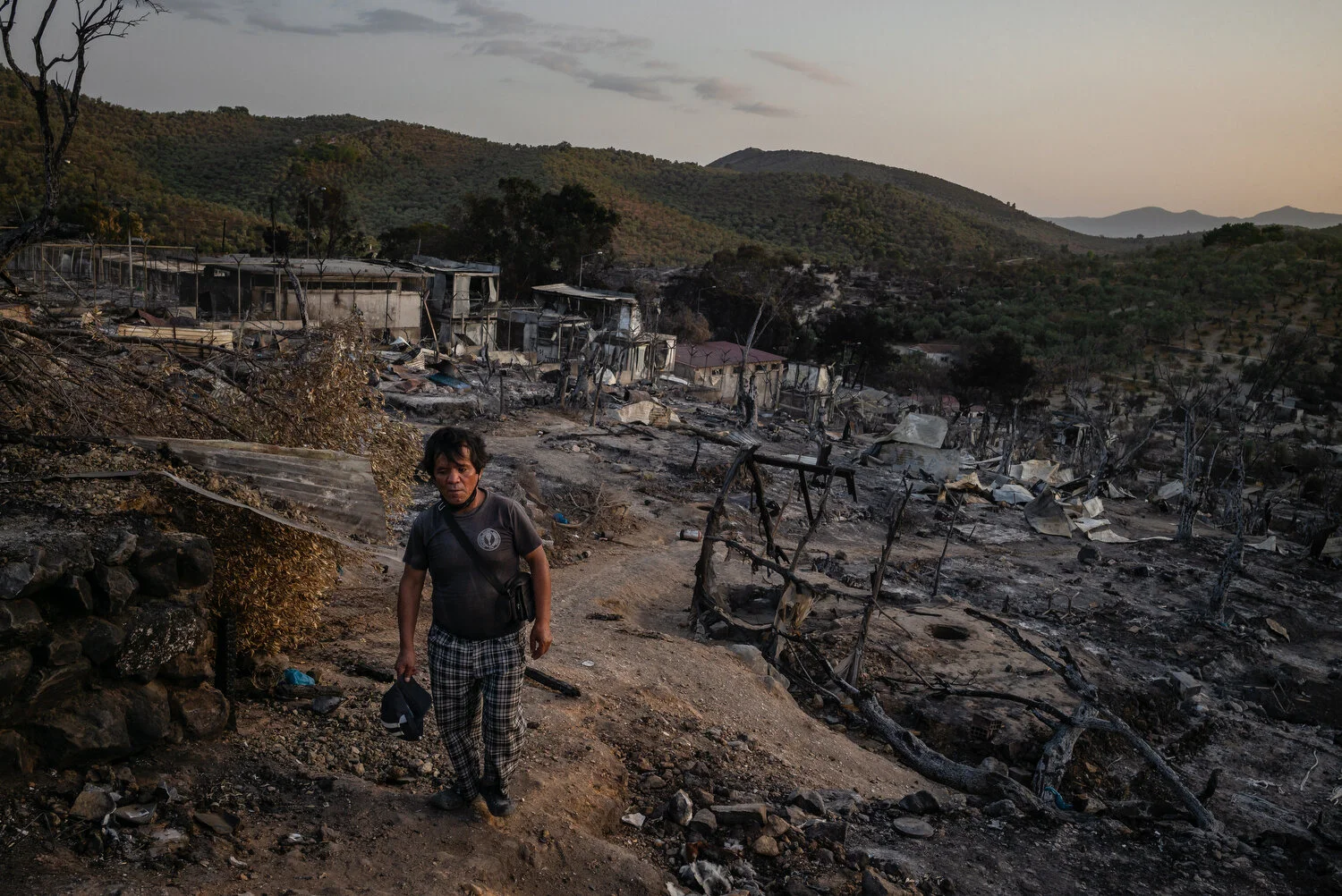


















This is an excerpt of an interactive multimedia long-read. To view the full story, please visit Shield of Europe.

Kara Tepe, Lesbos - 12/09/2020
Afghan migrant families seek shelter from the sun under a trailer after a fire destroyed the migrant camp Moria where they were living. After the fire, most asylum seekers fled to the surrounding streets. As the migrants moved towards nearby town Mytilini, they found their way blocked off by riot police. Authorities contained them on a small stretch of street for 10 days until a new emergency camp was ready.

Efthalou, Lesbos - 20/11/2019
The “Life Jacket Graveyard”. Life jackets and rubber boats left by migrants after they arrive on the island are dumped by authorities on a site near the northern coast of Lesbos.
Moria Camp, Lesbos - 25/11/2019
The Moria Camp on a rainy day, which are common in the winter season.

Moria Camp, Lesbos - 27/11/2019
An open spot in the Moria camp. When the official camp started overflowing with asylum seekers, newcomers began pitching tents in the surrounding olive groves. At the end of 2019, more than 20,000 migrants were living in the camp that was originally designed for 3,000 people.

Moria Camp, Lesbos - 27/11/2019
Children warming by a fire in the winter of 2019. Average temperatures drop to 5℃ at night during the winter. On some nights, the temperature drops below zero.

Moria Camp, Lesbos - 22/11/2019
Annaita, Mariam, and Mohammed Alim Akburu from Afghanistan, in the official Moria camp. Their family of eight shares the container with another large family. They have been on Lesbos for nine months, and are waiting for their asylum procedures to be completed. When the Taliban found out that Mohammed had worked for the US Army as a translator during the war, the family was threatened, had to flee their home and leave Afghanistan.
Moria Camp, Lesbos - 04/12/2019
Asylum seekers from Afghanistan keep warm by a fire on a rainy day in the Moria camp.

Moria Camp, Lesbos - 23/11/2019
Children playing at one of the ‘isoboxes’ inside the official parameters of the Moria camp. A container home is typically shared by two large families and divided into two compartments with a blanket for some privacy. Living in one of the containers is seen as a privilege that is mainly reserved for the most vulnerable families.

Moria Camp, Lesbos - 29/11/2019
Safar (age 6) on a sleeping bag at night, moments before she falls asleep. Two small pop-up tents joined together with a tarp serve as a home for the young Afghan girl and her family, who are staying in the Moria camp. Her grandfather says the camp is even worse than Afghanistan where he lost two sons, a daughter, and his home to the Taliban because of the family’s Hazara roots.

Moria Camp, Lesbos - 23/11/2019
A small shop in the hills of the Moria camp. As asylum procedures slowed, the migrants in the camp became stuck for many months and years. The camp began functioning as a small village. Shops and bakeries popped up around the olive grove.

Moria Camp, Lesbos - 23/11/2019
A young Afghan migrant looks out over the Moria Camp by a makeshift bakery.

Kara Tepe, Lesbos - 12/09/2020
Protestors express their anger at Greek riot police who broke up a peaceful protest with teargas, also affecting the children living in the street, in the aftermath of the Moria fire.
Moria Camp Lesbos - 08/09/2020
On the night of September 8th, 2020, a fire rages through Camp Moria. By dawn, the camp is almost completely destroyed. 12,767 asylum seekers become homeless overnight.

Moria Camp, Lesbos - 26/09/2020
Abdul Ali Akhlaghi (age 55) from Ghazni, Afghanistan walks through the ruins of the Moria camp. When it burned down in a large fire, it left nearly 13,000 migrants homeless, again. Akhlaghi's family is still in Iran, he calls them every night.

Kara Tepe, Lesbos - 10/09/2020
Qutaiba Alawad (age 28) from Syria is playing with his daughter Dana Alawad (age 3) on the second night after a fire destroyed the Moria camp where they were living. When he noticed the fire in the camp, Qutaiba hastily grabbed some blankets and fled to the streets with his family. “If this is Europe, we don’t want to be here,” he says. “All we want is our freedom and to be treated as human beings.”

Kara Tepe, Lesbos 15/09/2020
Hamida Mirzayi (age 50) is crying because she has lost track of her daughter after the Moria fire. Mirzayi found shelter in an abandoned building. She and her daughter have already been granted asylum, but they had stayed in the camp, waiting for her husband and son to be granted asylum too.

Moria Camp Area, Lesbos - 18/09/2020
Asylum seekers use the water from a broken irrigation hose to wash.

Kara Tepe, Lesbos - 12/09/2020
An Afghan migrant holds her child at a peaceful protest where they asked for freedom and to be allowed off the island.
Efthalou, Lesbos - 06/11/2020
Tattered Greek and European flags at the EU border crossing with Turkey, where most migrants arrive after crossing the Aegean Sea in a rubber boat.

Mavrovouni Camp - 01/10/2020
The line in front of the new camp that forms daily due to heavy security checks by Greek authorities. The asylum seekers in the camp are only allowed outside for limited periods of time. On Sundays and holidays, the camp is closed, and migrants are contained inside. Items such as cameras, alcohol, and pets are forbidden.

Mavrovouni Camp - 30/09/2020
Marjam Alizade (age 29) from Herat, Afghanistan sits on the outskirts of the new ‘emergency’ camp. Her husband Abdullah is fishing. They left Afghanistan with their 7-year-old daughter and have been on Lesbos for a year.